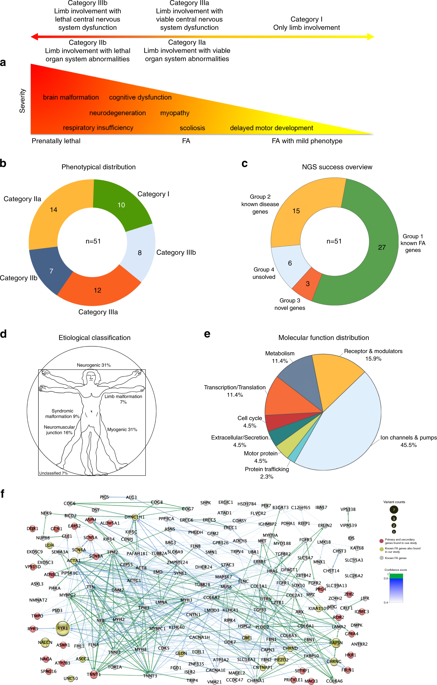Genetics in Medicine ( IF 8.8 ) Pub Date : 2019-11-04 , DOI: 10.1038/s41436-019-0680-1 Matthias Pergande 1, 2 , Susanne Motameny 3 , Özkan Özdemir 1, 2 , Mona Kreutzer 1, 2 , Haicui Wang 1, 2 , Hülya-Sevcan Daimagüler 1, 2 , Kerstin Becker 1, 2 , Mert Karakaya 1, 4 , Harald Ehrhardt 5 , Nursel Elcioglu 6, 7 , Slavica Ostojic 8 , Cho-Ming Chao 5 , Amit Kawalia 3 , Özgür Duman 9 , Anne Koy 2 , Andreas Hahn 10 , Jens Reimann 11 , Katharina Schoner 12 , Anne Schänzer 13 , Jens H Westhoff 14 , Eva Maria Christina Schwaibold 15 , Mireille Cossee 16 , Marion Imbert-Bouteille 17 , Harald von Pein 18 , Göknur Haliloglu 19 , Haluk Topaloglu 19 , Janine Altmüller 1, 3 , Peter Nürnberg 1, 3 , Holger Thiele 3 , Raoul Heller 4, 20, 21 , Sebahattin Cirak 1, 2, 21

|
Purpose
Fetal akinesia has multiple clinical subtypes with over 160 gene associations, but the genetic etiology is not yet completely understood.
Methods
In this study, 51 patients from 47 unrelated families were analyzed using next-generation sequencing (NGS) techniques aiming to decipher the genomic landscape of fetal akinesia (FA).
Results
We have identified likely pathogenic gene variants in 37 cases and report 41 novel variants. Additionally, we report putative pathogenic variants in eight cases including nine novel variants. Our work identified 14 novel disease–gene associations for fetal akinesia: ADSSL1, ASAH1, ASPM, ATP2B3, EARS2, FBLN1, PRG4, PRICKLE1, ROR2, SETBP1, SCN5A, SCN8A, and ZEB2. Furthermore, a sibling pair harbored a homozygous copy-number variant in TNNT1, an ultrarare congenital myopathy gene that has been linked to arthrogryposis via Gene Ontology analysis.
Conclusion
Our analysis indicates that genetic defects leading to primary skeletal muscle diseases might have been underdiagnosed, especially pathogenic variants in RYR1. We discuss three novel putative fetal akinesia genes: GCN1, IQSEC3 and RYR3. Of those, IQSEC3, and RYR3 had been proposed as neuromuscular disease–associated genes recently, and our findings endorse them as FA candidate genes. By combining NGS with deep clinical phenotyping, we achieved a 73% success rate of solved cases.
中文翻译:

胎儿运动不能的基因组和临床情况。
目的
胎儿运动不能有多种临床亚型,有超过 160 种基因关联,但其遗传病因尚不完全清楚。
方法
在这项研究中,使用旨在破译胎儿运动不能 (FA) 的基因组图谱的下一代测序 (NGS) 技术分析了来自 47 个无关家庭的 51 名患者。
结果
我们在 37 例病例中发现了可能的致病基因变异,并报告了 41 种新变异。此外,我们在 8 个病例中报告了推定的致病变异,其中包括 9 个新变异。我们的工作确定了胎儿运动不能的 14 种新的疾病基因关联:ADSSL1、ASAH1、ASPM、ATP2B3、EARS2、FBLN1、PRG4、PRICKLE1、ROR2、SETBP1、SCN5A、SCN8A和ZEB2。此外,一对兄弟姐妹在TNNT1中含有纯合拷贝数变体,一种极为罕见的先天性肌病基因,通过基因本体分析与关节弯曲症有关。
结论
我们的分析表明,导致原发性骨骼肌疾病的遗传缺陷可能未被充分诊断,尤其是RYR1的致病性变异。我们讨论了三个新的假定胎儿运动不能基因:GCN1、IQSEC3和RYR3。其中,IQSEC3和RYR3最近被提议作为神经肌肉疾病相关基因,我们的研究结果支持它们作为 FA 候选基因。通过将 NGS 与深度临床表型相结合,我们实现了 73% 的解决病例成功率。



























 京公网安备 11010802027423号
京公网安备 11010802027423号